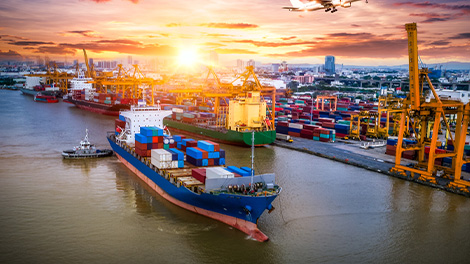
How do I export products out of the UK to the EU
In 2022, UK goods exports to the EU totalled £196.6bn, the year trade recovered to its pre-Brexit levels. After years of uncertainty, its hoped businesses are set for a prolonged period of stability in trading regulations, courtesy of the EU-UK Trade and Cooperation Agreement.
That being said, the process of exporting goods from the UK to the EU isn’t as simple as previously, now that goods are moving into a different customs union. Businesses have many additional obligations to ensure are transported smoothly. This page contains guidance on ensuring a succinct logistical process when sending products into the European Union.
Exporting Process
To complete export declarations, you need to ensure you have an agent. While you can complete these yourself, it can be a very challenging and time-consuming process. Below, you can see an overview of export requirements from the UK post-January 2021.
01
Get your UK EORI number
(EU EORI if selling on DDP incoterms*).
02
Check any extra certification or licences
03
Understand VAT rules for both GB exporter and EU importer
Exports are zero rated for VAT. Intrastat remains.
04
Comply with regulations
in areas such as food labelling CE marking and reach regulations for chemicals.
05
Will you use a customs intermediary or make your own declarations?
06
Ask if any customs special procedures and authorisations apply
Consider transit procedures.
07
Check EU common external tariff
Re what duties or quotas apply against your product.
08
Work closely with all stakeholders
including EU buyer and freight forwarder.
09
Ensure EU importer has all necessary information
EORI number, export declarations and any additional licences & clarification.
10
Consider impacts for rest of world trade and rules of origin
Documentation
To export from the UK to the EU, you will need to complete a wide range of different documents. Submission of your export paperwork needs to be done at least 24hrs in advance and you need to be in receipt of the “Permission to proceed” (P2P). All export information needs to be submitted electronically.
The relevant documents cover export and customs and if your goods are being trucked over to Europe, the driver will need to have all the necessary customs documentation to allow them to cross international borders.
The relevant documents may be:
Commercial invoice
Certificates of origin
Licences and certificates
Such as for food or plants.
The Export or Transit Accompanying Document (TAD) issued by customs
There is so much additional paperwork that is required that there is a huge benefit to using a forwarder who has long standing relationships in place with best in class hauliers and digital systems in place that can automate a lot of these functions and give you the peace of mind that your goods will be cleared once they arrive in Europe
Brexit Changes
The UK has left the EU Customs Union. As a result, VAT on exported goods now works differently.
The UK no longer has to comply with the EU's minimum VAT rate of 15 per cent. However, since the UK's VAT rate sits at 20 per cent, nothing is likely to change in this regard.
As Brexit continues to have an impact on exports, WTA UK will continue to provide as much information as possible to make the process more transparent for those looking to export from the UK. For more information about Brexit and its impact on exports, click here to explore WTA’s Brexit knowledge base.
If you need help understanding the confusing jargon surrounding imports and experts, we have a helpful ‘Jargon Buster’ to help you understand the important terms quickly.
Additional resources for exporting from the UK.
Export your way out of recession
Discover how to maintain growth in your business whilst tackling a downturn in the economic climate.
Key documents for exporting
Learn about all the key documents you need to export successfully.
10 exporting tips for UK firms
Read out 10 quick-fire tips for exporting products out of the UK.








